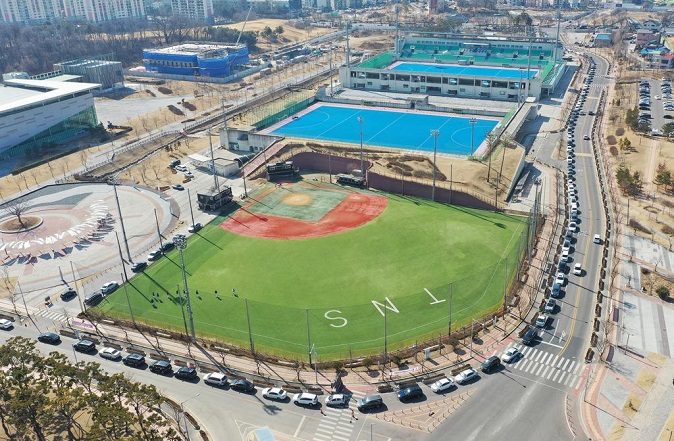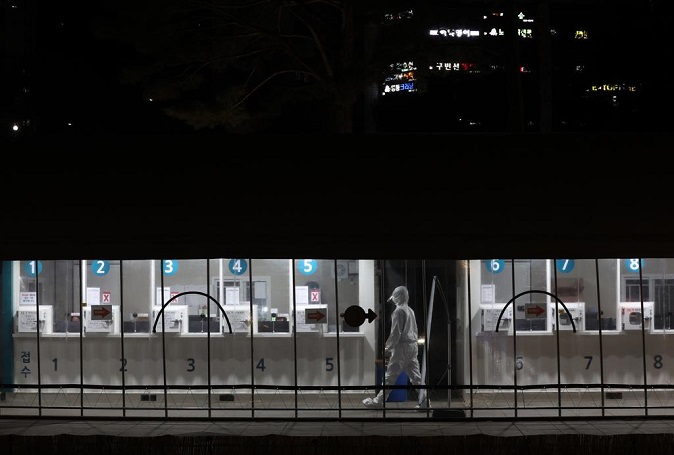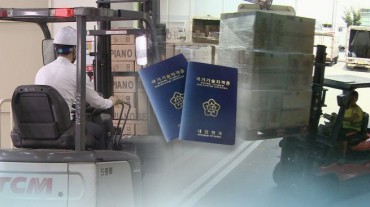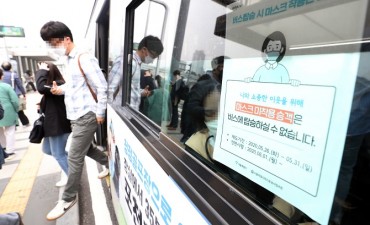
Passenger cars form a long line as drive-through coronavirus testing is carried out at a pop-up screening clinic in Incheon, west of Seoul, on Feb. 24, 2022. (Yonhap)
SEOUL, Feb. 24 (Korea Bizwire) — South Korea’s daily COVID-19 cases stayed above 170,000 for the second consecutive day Thursday amid the fast spread of the highly contagious omicron variant across the country.
The country reported 170,016 new COVID-19 infections, including 169,846 local cases, raising the total caseload to 2,499,188, according to the Korea Disease Control and Prevention Agency (KDCA).
Daily infections surpassed the 100,000 level for the first time last week and soared to a record high of 171,452 on Wednesday. Thursday’s figure marked a threefold increase from two weeks ago.
The number of critically ill COVID-19 patients came to 581, up sharply from the previous day’s 512. The figure rose nearly threefold in a week.
Intensive care unit beds set aside for critically ill patients were 39.1 percent occupied nationwide, compared with around 10 percent earlier this month.
The country added 82 more deaths from COVID-19 on Thursday, raising the death toll to 7,689. The fatality rate was 0.31 percent, according to the KDCA.
Of the deaths reported in the day, two were younger than age 9, bringing the total deaths among the age group to five.
The rise in total infections pushed up the number of patients receiving at-home treatment to an all-time high of 587,798, the KDCA said.
As of 9 p.m. Thursday, health authorities and local governments had reported an additional 143,229 COVID-19 cases nationwide, down 18,153 from the same time the previous day. Daily cases are counted until midnight and announced the following day.
The health authorities have said that the omicron wave could reach a peak by early next month, with the daily caseload rocketing up to 270,000. On Wednesday, a state-run institute said the daily caseload could spike to over 330,000 in two weeks.
Wednesday’s tally of over 170,000 cases marked the world’s second largest daily infections after Germany, which reported 221,478 new patients, according to a statistics site, Our World in Data.
But South Korea’s number of seriously ill patients has stayed far lower than other nations, the KDCA said.
For South Korea, 9.36 people were critically ill COVID-19 patients per 1 million individuals, while the corresponding figures for the United States and Germany stood at 31.4 persons and 28.6, respectively.
“We’ve seen a growing number of deaths and seriously ill patients in recent days. How to manage the situation is a crucial task for us,” KDCA official Lim Sook-young said.
Officials said the omicron surge is a “necessary” step to move on to an endemic phase from the pandemic, citing its milder severity, and the current “select and focus” scheme with an enhanced at-home treatment system will be in place to weather the omicron wave.
The government said it will seek measures to better provide proper treatments to stay-at-home patients when their conditions worsen, due to growing complaints by citizens over what they called the government’s “hands-off” strategy.
Currently, some 340 clinics accept COVID-19 emergency patients, but the government vowed to reserve more hospitals for first aid for coronavirus patients.
It also plans to beef up the workforce in charge of managing at-home treatment patients and for other supportive roles.
As for criticism that the government has been too hasty in relaxing antivirus curbs, Health Minister Kwon Deok-cheol said that the country adjusted quarantine steps in accordance with features of the omicron variant.
He also dismissed speculation that the government’s decision to ease restrictions was intended to woo voters amid an outcry from small merchants ahead of the March 9 presidential election.
“The government has long worked on a new quarantine scheme to curb the omicron wave, and it has nothing to do with the election,” Kwon said.
“We will continue to focus on dealing with the growth in the number of patients, while devising an exit strategy to prepare for the next phase.”
As of Wednesday, 30.85 million people, or 60.1 percent of the country’s 52 million population, had received booster shots. The number of fully vaccinated people came to 44.32 million, accounting for 86.4 percent, according to the KDCA.
The government once again called on the people to get vaccinated, as a booster shot reduces chances of developing serious cases, as well as deaths from COVID-19, by more than 80 percent under the current wave.
(Yonhap)







